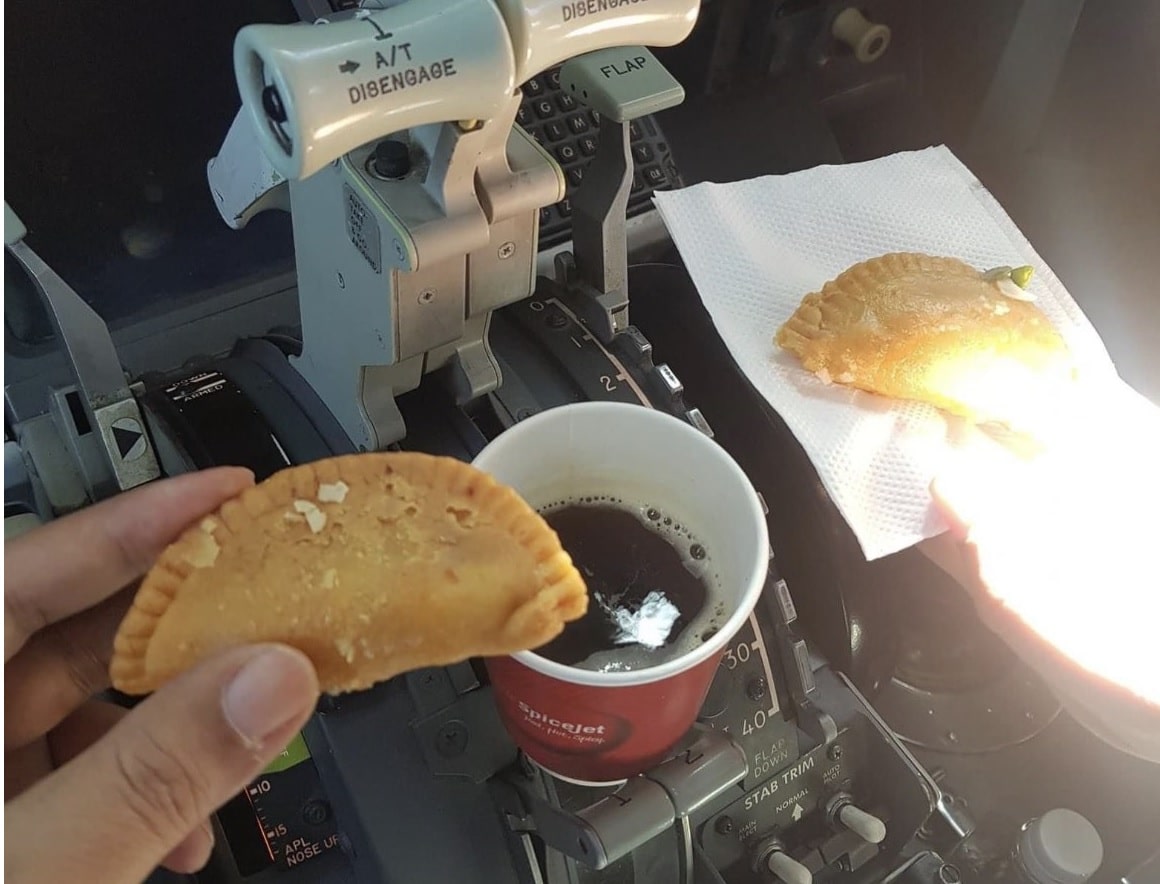Aerospace
Two Spice Jet pilots were grounded by just one photo.

The pilots are the most important aspect of safe flight, and several standards are in place to help them maintain the standard operating procedure. One photo is circulating on the internet that resulted in the grounding of two pilots. The image is of the Spicejet aircraft pilots, who are shown eating snacks while keeping beverages in the cockpit with crucial controls. Now comes the debate regarding the safety considerations and normal standards for consuming meals in the cockpit.
This was captured during the Indian Holi celebrations when they were operating a flight from Delhi to Guwahati last Wednesday. The two had a cup of liquid on the flight deck’s center console, where even a small leak might have jeopardized safety. After a photo of the celebration at 37,000 feet while the plane was traveling at 0.79 mach (975 kmph) went viral, the Directorate General of Civil Aviation (DGCA) on Tuesday demanded the airline quickly identify and prosecute the crew members. In accordance with the directive, the airline off-rostered (removed from flying duties) the pilots a day later.
Appalling & extremely unprofessional behaviour by @flyspicejet pilots.
If the liquid (resting on the fuel cutoff levers) spills, it can short circuit the electronics affecting a range of systems and compromise the aircraft’s ability to fly safely.@DGCAIndia @JM_Scindia pic.twitter.com/2n7O5daIg1
— Bandit (@BanditOnYour6) March 14, 2023
“Both pilots have been de-registered awaiting an investigation. SpiceJet has stringent regulations concerning food eating in the cockpit, which is followed by all flight crew. Following the completion of the investigation, appropriate disciplinary action will be taken,” a SpiceJet spokeswoman stated. Veteran pilots have raised their alarm about the dangerous celebration. “The coffee cup has been placed on the aircraft’s fuel levers on the center console.
The engine and (auxiliary power unit) fire control switches are located just below. If the coffee spills and falls over the fire panel, it may cause a short circuit, resulting in a false fire alarm. The team must release fire bottles and declare an emergency.

Aerospace
Boeing Transfers Rocket Stage to NASA, Paving Way for Human Moon Mission

Boeing has achieved a significant milestone by providing NASA with the second core stage of the Space Launch System (SLS) rocket.
This crucial component, crafted at NASA’s Michoud Assembly Facility (MAF), is set to propel the Artemis II crew into lunar orbit, marking humanity’s return to deep space after a 50-year hiatus.
The monumental Boeing-built rocket stage, the largest element of the Artemis II mission, will embark on a journey aboard the Pegasus barge, traveling 900 miles to NASA’s Kennedy Space Center.
Comparison of two legendary aircraft B777x vs B747 aircraft:Click here
Upon arrival, it will be meticulously integrated with other essential Artemis II components, including the upper stage, solid rocket boosters, and NASA’s Orion spacecraft within the iconic Vehicle Assembly Building. This intricate integration process is a vital step toward the eagerly anticipated Artemis II launch, slated for 2025.
“Boeing-built products helped land humankind on the moon in 1969, and we’re proud to continue that legacy through the Artemis generation,” remarked Dave Dutcher, vice president and program manager for Boeing’s SLS program. “Together, with NASA and our industry partners and suppliers, we are building the world’s most capable rocket and paving the way to deep space through America’s rocket factory in New Orleans.”
NASA, Lockheed Martin Reveal X-59 Quiet Supersonic Aircraft:Click here
The delivery of Core Stage 2 marks a significant achievement in the evolution of the SLS rocket. Towering over 200 feet and powered by four RS-25 engines, this core stage, coupled with two solid-fueled booster rockets, will generate a staggering 8.8 million pounds of thrust. This immense power is crucial to launching Artemis II and future missions into the vast expanse of space.
The SLS rocket stands unparalleled in its capability to transport both crew and substantial cargo to the moon and beyond in a single launch. Its extraordinary capacity will facilitate the delivery of human-rated spacecraft, habitats, and scientific missions to destinations including the moon and Mars, ushering in a new era of space exploration.
-

 Travel1 week ago
Travel1 week agoAir India to Expand US Operations with Three New Routes After a Decade
-

 Travel2 weeks ago
Travel2 weeks agoWhy We Should Avoid These Stamps in a Passport
-

 Airlines1 month ago
Airlines1 month agoInvestigations Reveal Fake Chinese Titanium in Boeing and Airbus Jets
-

 Tech4 weeks ago
Tech4 weeks agoChina’s CATL Plans 1,800-Mile Electric Plane Launch by 2027
-

 Airport3 days ago
Airport3 days agoTop 10 Largest Airports in the World by Size
-

 Aerospace4 weeks ago
Aerospace4 weeks agoChina’s Fighter Jets Turn Wings into Autonomous Drones
-

 Airlines4 days ago
Airlines4 days agoAir India Rolls Out A350s for Delhi-New York JFK and Newark Routes
-

 Defence3 weeks ago
Defence3 weeks agoBoeing Enhances Chinook with New Engines and Block II Upgrades at $96 Million







